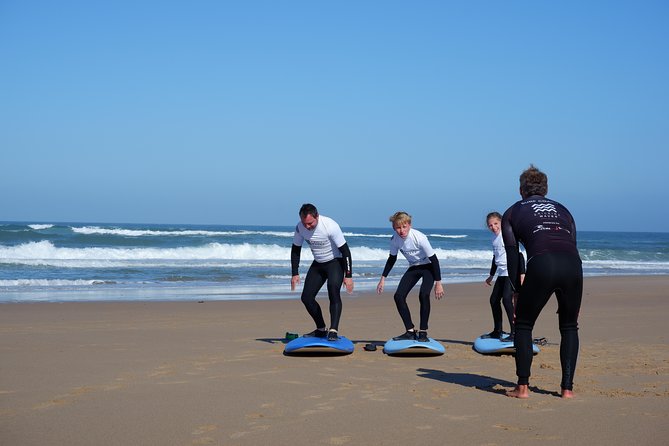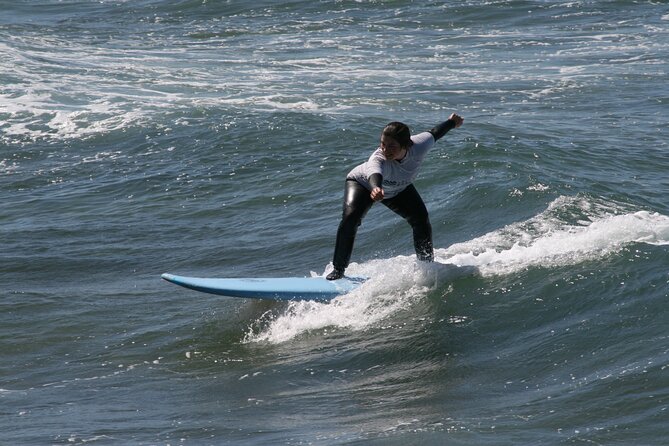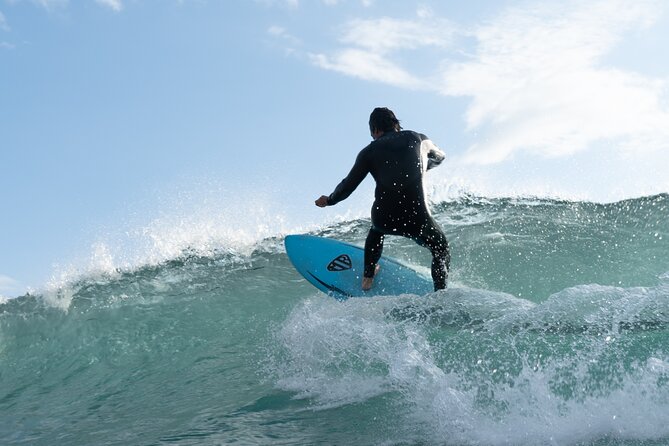Surfing: the ultimate challenge, where one must conquer the mighty waves and harness the power of the ocean.
For those embarking on this thrilling journey, surf lessons are the key to unlocking the secrets of riding the surf with finesse and style.
Whether you’re a beginner testing the waters for the first time or an advanced surfer seeking to push your limits, these lessons offer a roadmap to success.
From the provision of top-notch equipment to the guidance of experienced instructors, this discussion will explore the world of surf lessons, providing insight into the techniques and skills that will take your surfing to new heights.
So grab your board and dive into the adventure that awaits!
This experience made our list of the 10 Best Workshops And Classes In Cascais.
Good To Know

- Surf lessons for all levels include top-quality equipment such as Rip Curl surfboards and boots, as well as Softboards.
- Proper equipment enhances performance and ensures the safety of the surfer.
- Beginners should choose longboards or softboards for stability and buoyancy.
- Observing the ocean and recognizing wave patterns is crucial for beginners.
Equipment and Inclusions

Surf lessons for all levels include top-quality equipment such as Rip Curl surfboards and boots, as well as Softboards, ensuring a safe and enjoyable experience for beginners, intermediate, and advanced surfers alike. The importance of proper equipment in surfing can’t be overstated. Having the right gear not only enhances performance but also ensures the safety of the surfer. With Rip Curl surfboards and boots, surfers can confidently ride the waves, knowing that they’ve reliable equipment supporting them.
Plus, including meals and drinks in surf lessons provides numerous benefits. Surfing is a physically demanding activity, and having nourishing meals and hydration throughout the day helps maintain energy levels and keeps surfers refreshed and focused. It also allows participants to take breaks and socialize, fostering a sense of community and camaraderie among fellow surf enthusiasts.
More tours and activities we've covered in Cascais
Meeting and Pickup Details

When arriving at the meeting point for your surf lesson, keep an eye out for the van and board trailer at the entrance of Estacionamento Praia de Ribeira dIlhas in Ericeira, Portugal. This is where the adventure begins!
Here are some key details to know about the meeting and pickup process:
Pickup Schedule: Surf lessons are available from Monday to Sunday, starting between 8:00 AM and 9:00 AM. Be sure to arrive on time to make the most of your lesson.
Accessibility Options: The meeting point is wheelchair accessible, ensuring that everyone can join in on the fun. Service animals are also allowed, making it convenient for those who may need assistance.
Adventure Awaits: From the moment you spot the van and board trailer, you can feel the excitement building. Get ready to embark on an unforgettable surfing experience with experienced instructors and top-notch equipment.
Get ready to ride the waves and make unforgettable memories at Estacionamento Praia de Ribeira dIlhas!
Surfing Techniques for Beginners
Get ready to dive into the world of surfing as we explore essential techniques for beginners, allowing you to ride the waves with confidence and style. When it comes to choosing the right surfboard, beginners should opt for a longboard or a softboard. These boards provide stability and buoyancy, making it easier to balance and catch waves. Understanding wave patterns is crucial for beginners. Waves break in different ways, such as beach breaks, reef breaks, and point breaks. By observing the ocean and recognizing wave patterns, beginners can position themselves in the right spot to catch the best waves. Check out the table below for a visual representation of the surfboard types and wave patterns:
| Surfboard Types | Wave Patterns |
|---|---|
| Longboard | Beach Breaks |
| Softboard | Reef Breaks |
| Point Breaks |
Surfing Techniques for Intermediate Surfers
As beginners become more comfortable on their longboards or softboards and gain a better understanding of wave patterns, they’re ready to progress to the next level of surfing techniques as intermediate surfers.
Here are three essential techniques for intermediate surfers to take their skills to the next level:
Surfboard Selection: Intermediate surfers should experiment with different board types, such as shortboards or fish boards, to find the one that suits their style and wave conditions. This allows them to develop their own personal style and maximize their performance on the waves.
Wave Reading Techniques: Intermediate surfers should focus on honing their ability to read waves. This involves understanding how to identify different types of waves, their shapes, and their energy. By accurately reading waves, surfers can position themselves in the right spot, time their take-offs perfectly, and execute maneuvers with precision.
Learning Advanced Maneuvers: Intermediate surfers can start learning advanced maneuvers such as bottom turns, cutbacks, and floaters. These maneuvers require a combination of timing, technique, and confidence. Mastering these moves allows surfers to flow with the wave and add style and flair to their surfing.
Surfing Techniques for Advanced Surfers
Advanced surfers take their skills to new heights, pushing the boundaries of their abilities and seeking the thrill of conquering challenging waves.
To enhance their performance, advanced surfers need to master advanced surfboard selection and wave reading techniques.
When it comes to choosing an advanced surfboard, it’s crucial to consider factors such as board dimensions, tail shape, and fin setup. These customized boards offer increased maneuverability and responsiveness, allowing surfers to execute complex maneuvers with ease.
Plus, advanced surfers must develop advanced wave reading techniques. This involves analyzing wave conditions, understanding the wave’s shape, and identifying the best take-off point.
By honing these skills, advanced surfers can maximize their performance and make the most of every wave they ride.
With the right equipment and technique, they’re ready to conquer any challenging wave that comes their way.
Tips for Improving Surfing Skills
After mastering advanced surfboard selection and wave reading techniques, experienced surfers can now focus on refining their skills and taking their surfing to the next level. Here are three tips for improving their surfing skills:
Perfect your balance: Balancing is crucial in surfing. Practice balancing techniques both on and off the board to improve your stability and control on the waves. This will help you maintain better control over your board and execute maneuvers with ease.
Analyze your mistakes: Reflect on your surfing sessions and identify any common mistakes you make. It could be your positioning on the wave, timing, or technique. By recognizing and addressing these mistakes, you can make conscious efforts to improve and progress in your surfing abilities.
Push your limits: Challenge yourself by trying new maneuvers and taking on more challenging waves. Pushing your limits will help you expand your skill set, build confidence, and ultimately become a better surfer.
Common Questions
What Is the Minimum Age Requirement for Participants in the Surf Lessons?
The minimum age requirement for participants in the surf lessons is not specified. However, safety precautions are taken into consideration to ensure the well-being and enjoyment of all participants.
Can Participants Use Their Own Surfboards and Wetsuits During the Lessons?
Participants have the option of using their own surfboards and wetsuits, or renting equipment from the surf school. This allows them to choose what they are most comfortable with during their surf lessons.
Are There Any Specific Requirements or Restrictions for Participants With Physical Disabilities?
There are no specific requirements or restrictions for participants with physical disabilities. The surf lessons are wheelchair accessible and service animals are allowed. Adaptive equipment is available for disabled surfers at accessible surf locations.
How Many Instructors Are Typically Assigned to Each Group of Surfers?
Typically, there is a good instructor to surfer ratio to ensure personalized attention and safety. Group size limitations may vary, but the aim is to create a dynamic and interactive learning environment.
Is It Possible to Book Private Lessons Instead of Joining a Group Lesson?
Yes, it is possible to book private surf lessons instead of joining a group lesson. The benefits of one-on-one surf instruction include personalized coaching, focused attention, and the ability to progress at your own pace.
The Sum Up
So whether you’re a beginner looking to catch your first wave, an intermediate surfer wanting to fine-tune your skills, or an advanced rider seeking new challenges, these surf lessons have got you covered.
With top-notch equipment, experienced instructors, and a focus on safety, you’ll have all the tools you need to ride the waves with confidence.
So don’t miss out on the opportunity to improve your surfing skills and experience the thrill of the ocean.
Get set for an unforgettable adventure in the world of surfing!
More Workshop Tours in Cascais
More Tour Reviews in Cascais
Looking for something different? Other Cascais activities we've written about
- Cascais: Dolphin Watching Tour
- One Way Lisbon to Algarve, through SW Natural Park, Porto Covo, Sagres, Lagos
- Surf Lesson with transfer
- Dolphin Watching Experience in Cascais
- Cascais Private Sailing Yacht Cruise
- Transfer From Lisbon To Seville Spain
- Amazing Tour on Classic Venetian Boat With Drinks
- Cascais: Family Fishing
- Cascais: Casa da Guia Rock Climbing Experience by the Sea
- Cascais: Beach & Village Visit Full Day Private Guided Tour
- Cascais: Atlantic Coastline Wild Hike
- Cascais: Dolphin Watching Tour
